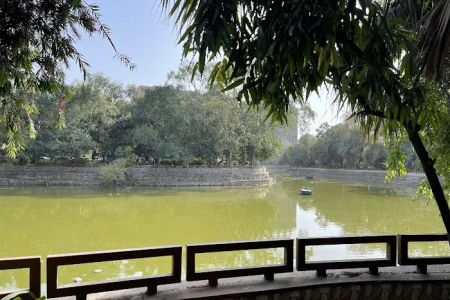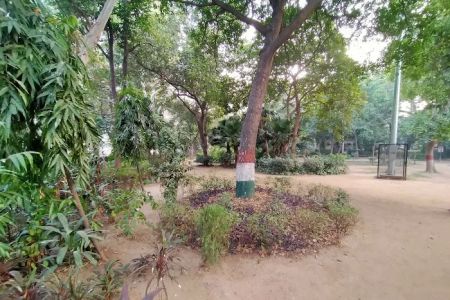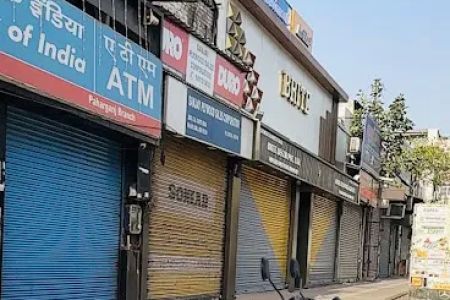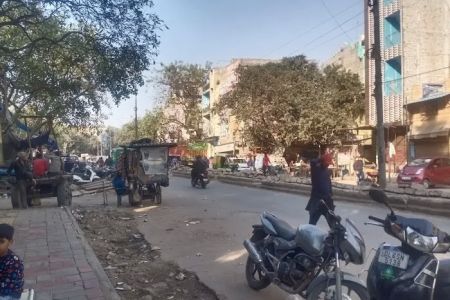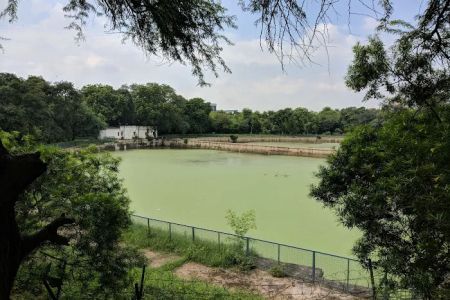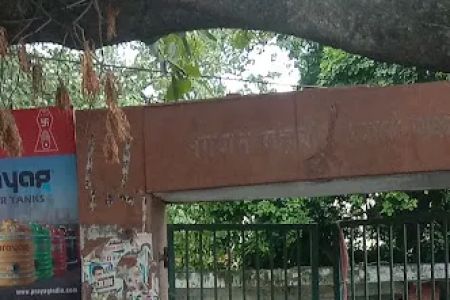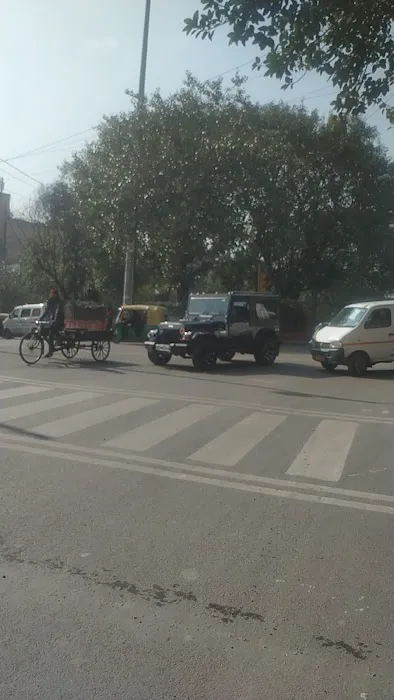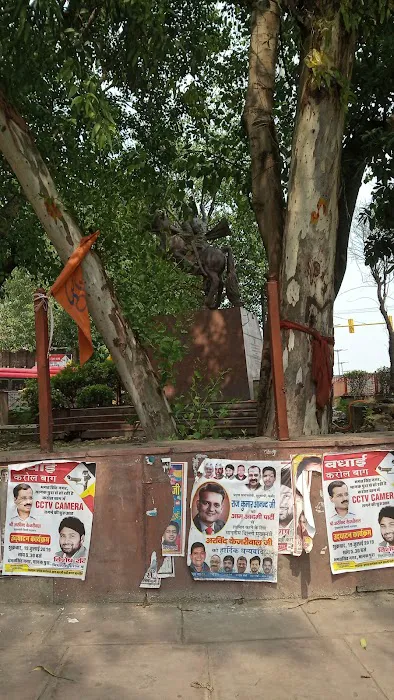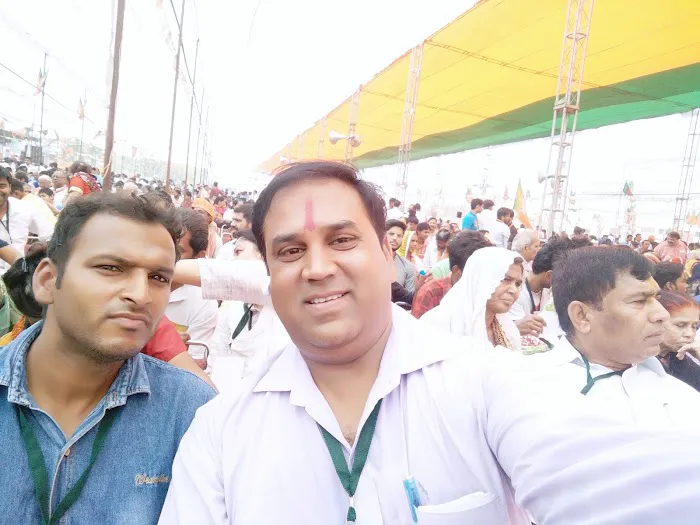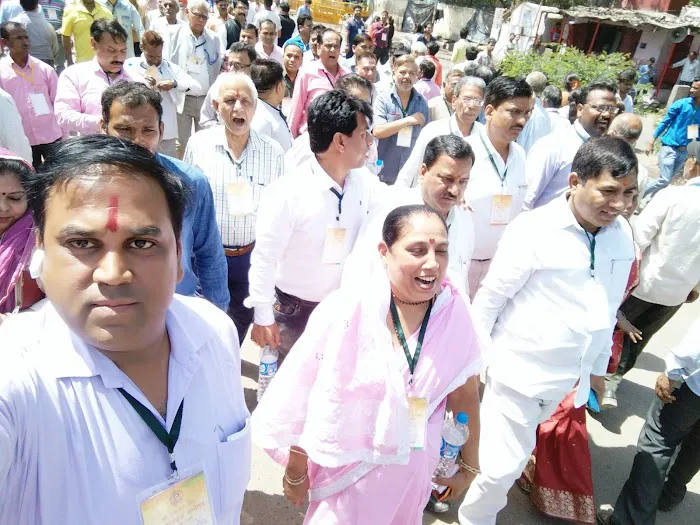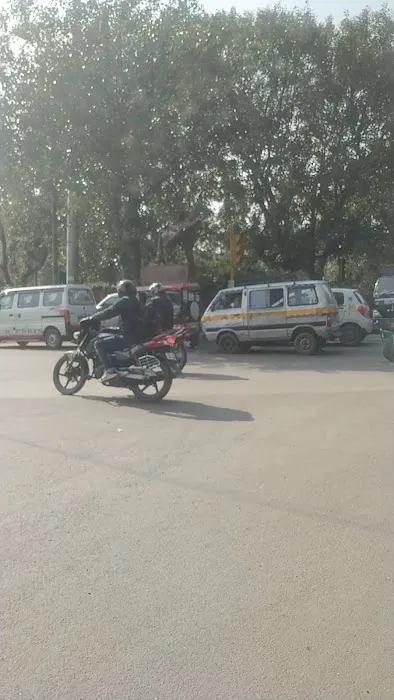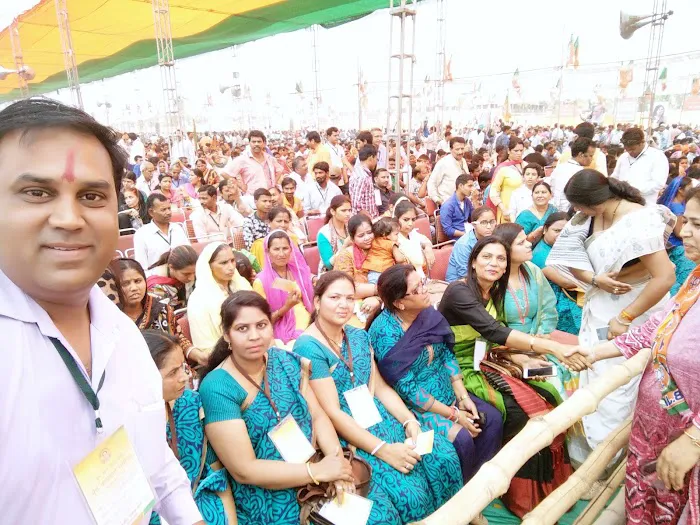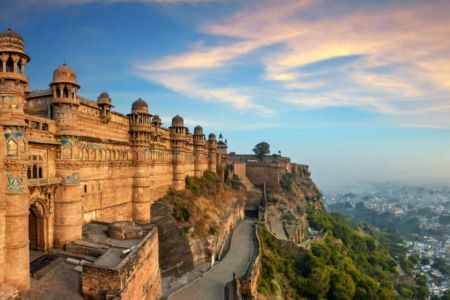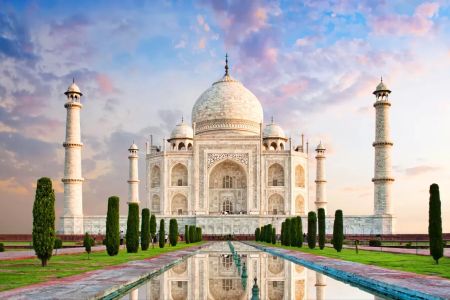In the bustling heart of New Delhi, amidst the constant flow of traffic and the vibrant energy of the city, stands a powerful and poignant tribute to one of India's most valiant historical figures: the Rani Jhansi Statue. Located at a prominent roundabout in the Jhandewalan area, this grand monument to Rani Lakshmibai, the Queen of Jhansi, serves as a daily reminder of courage, sacrifice, and unwavering determination. For generations of Delhiites, this statue is more than just a piece of art; it's a symbol deeply etched into the city's consciousness, representing the fierce spirit of resistance against colonial rule.
The statue depicts Rani Lakshmibai in a dynamic pose, often shown with a child on her back, capturing the iconic image of her fighting bravely during the First War of Indian Independence in 1857. This visual representation resonates deeply with the local populace, symbolizing not only her personal valor but also the strength and resilience of Indian women throughout history. It stands as an inspiration, encouraging people to remember the sacrifices made for the nation's freedom and to embody similar qualities in their daily lives.
The presence of such statues in public spaces is a deliberate effort to keep history alive and accessible to everyone. The Rani Jhansi Statue, situated at a vital junction connecting North and Central Delhi, ensures that thousands of commuters pass by it daily, offering a moment for reflection amidst their busy routines. It transforms a mere traffic intersection into a site of historical contemplation and patriotic pride. Its very location imbues it with a sense of public ownership and significance, making it a landmark that locals not only recognize but also deeply respect.
While it is not a "park" in the traditional sense of a recreational green space, this monument is a significant public area that draws attention and serves a civic purpose. It's a place where history is commemorated, and a powerful narrative is told without words. This article aims to delve deeper into the significance of the Rani Jhansi Statue, detailing its location, what it represents, and why it continues to be a cherished landmark for the people of Delhi.
It's important to view such monuments as open-air historical markers that play a crucial role in civic education and national remembrance. They are points of pride and identity for a city, encouraging passersby to connect with their heritage. The Rani Jhansi Statue is a prime example of how public art can serve as a constant, subtle reminder of the values and historical struggles that have shaped a nation. Its commanding presence ensures that the legacy of Rani Lakshmibai remains vibrant and inspiring for current and future generations of Delhiites.
Location and Accessibility
The Rani Jhansi Statue is strategically located at J6W4+J4F, Rani Jhansi Rd, Motia Khan, Jhandewalan, New Delhi, Delhi 110005, India. This address places it at a prominent roundabout, which is a key intersection connecting various parts of Delhi, particularly North and Central Delhi. Its position at a major traffic artery ensures maximum visibility and accessibility for a vast number of daily commuters and visitors.
For those utilizing the Delhi Metro, the statue is quite accessible. The nearest metro stations are:
- Jhandewalan Metro Station (Blue Line): This station is relatively close, and from there, one can easily take a short auto-rickshaw ride or even walk to the statue, depending on the exact exit and preference.
- Ramakrishna Ashram Marg Metro Station (Blue Line): Also a viable option, from where the statue can be reached by a short commute via auto-rickshaw or local bus.
- New Delhi Metro Station (Yellow Line & Airport Express Line): While a bit further, it’s a major interchange and well-connected. From New Delhi Metro, one can take an auto-rickshaw or local bus to the Rani Jhansi Road roundabout.
The extensive Delhi Metro network ensures that residents from almost any part of the city can reach the vicinity of the statue with relative ease.
The statue is situated on Rani Jhansi Road itself, which is a significant thoroughfare in Central Delhi. This road connects to other major roads, facilitating easy access for those traveling by personal vehicles, taxis, or local buses. Numerous bus routes ply along Rani Jhansi Road, providing direct connectivity from various residential and commercial areas across Delhi. Auto-rickshaws are also readily available throughout the area, offering convenient last-mile connectivity to the roundabout.
The surrounding area of Jhandewalan and Motia Khan is a mix of residential, commercial, and institutional establishments. This vibrant locality ensures that the statue is not just an isolated monument but is integrated into the daily lives of thousands of people. Its central and well-connected location makes the Rani Jhansi Statue a highly visible and easily reachable landmark for all Delhiites, serving as a constant reminder of its historical significance.
Services Offered
As a standalone statue and roundabout, the "Rani Jhansi Statue" does not offer commercial "services" in the traditional business sense. It is a public monument. However, its presence in a prominent public space offers several indirect "services" or public benefits to the local community and visitors alike:
- Historical Education and Remembrance: The primary "service" it offers is to serve as a constant visual reminder and educational tool about Rani Lakshmibai and her pivotal role in India's First War of Independence. It helps in preserving and promoting national history and patriotism among the public.
- Cultural Landmark and Navigation Aid: The statue acts as a significant cultural landmark and a familiar point of reference for navigation within Delhi. Locals often use it as a meeting point or a directional cue, facilitating easier movement and orientation in the city's complex road network.
- Civic Pride and Inspiration: It serves as a source of civic pride for Delhiites, symbolizing courage, resilience, and the spirit of independence. For many, it offers inspiration and a connection to their national heritage.
- Public Art and Aesthetic Value: As a large, well-crafted statue, it contributes to the aesthetic appeal of the urban landscape. It's a piece of public art that enhances the visual environment of the roundabout and the surrounding area.
- Reflection and Contemplation Space: For some individuals, the statue might offer a momentary space for reflection on historical events and national values amidst the daily hustle and bustle of city life.
- Informal Meeting Point: Due to its prominent and easily recognizable nature, it often serves as an informal meeting point for individuals or small groups.
It's important to note that these are not commercial services for which a fee is charged, but rather the inherent public benefits derived from having such a monument in a significant urban location.
Features / Highlights
- Large and Prominent Statue: The most striking feature is the impressive size and prominent placement of the statue at a major roundabout, making it highly visible and a significant landmark in Central Delhi.
- Symbol of Courage and Patriotism: It is a powerful sculptural representation of Rani Lakshmibai, commemorating her bravery and pivotal role in the 1857 uprising, inspiring a sense of national pride and courage among viewers.
- Strategic Location: Situated at the nexus of roads connecting North and Central Delhi, it is an important geographical marker and a constant presence for thousands of daily commuters.
- Historical Significance: The statue serves as a tangible link to India's struggle for independence, educating passersby about a critical period in the nation's history.
- Iconic Depiction: Often portrayed with a child on her back while fighting, the statue captures one of the most enduring and poignant images of Rani Jhansi, making it instantly recognizable and emotionally resonant.
- Civic Integration: Unlike isolated monuments, this statue is seamlessly integrated into the active urban fabric, making history a part of everyday life for Delhiites.
- Public Art Contribution: It adds significant aesthetic and cultural value to the urban landscape, enhancing the environment of the busy roundabout.
Promotions or Special Offers
As a public monument, the "Rani Jhansi Statue" does not offer commercial "promotions" or "special offers" in the way a business would. There are no discounts, loyalty programs, or seasonal sales associated with visiting the statue. Its value to the public is intrinsic, derived from its historical significance and its role as a civic landmark. However, from the perspective of a local user, the "special offers" or benefits of this site are inherent and continuous:
- Free Access to History and Inspiration: The primary "offer" is the free and unrestricted access to a powerful symbol of courage and patriotism. It provides a constant, open-air history lesson and a source of inspiration for all who pass by, without any entry fee or cost.
- Enhanced Civic Awareness: By being prominently displayed, the statue actively contributes to the civic awareness and historical knowledge of Delhi's citizens. This continuous educational benefit is a "promotion" for a more informed and patriotic populace.
- Landmark for Navigation: Its status as a well-known landmark offers the "special offer" of simplified navigation. Locals often use "Rani Jhansi Statue" as a reference point for directions, making it easier to pinpoint locations in the surrounding areas.
- Cultural Enrichment: The statue enriches the urban landscape and cultural fabric of Delhi. It’s a piece of public art that contributes to the city’s identity and cultural heritage, a constant "offer" to enhance the daily environment.
- Timeless Reminder: Unlike fleeting commercial promotions, the statue offers a timeless reminder of the sacrifices made for India's freedom, serving as an ongoing source of pride and reflection for generations.
In essence, the "promotions" of the Rani Jhansi Statue are its enduring public benefits – its role as a historical beacon, a navigational aid, and a source of inspiration – all offered freely to the people of Delhi.
Contact Information
The Rani Jhansi Statue is a public monument located at a traffic roundabout. As such, it does not have a dedicated contact number, email address, or official website, unlike a commercial business or a managed park. It is maintained by civic authorities, likely the Municipal Corporation of Delhi (MCD) or the Public Works Department (PWD).
Address: J6W4+J4F, Rani Jhansi Rd, Motia Khan, Jhandewalan, New Delhi, Delhi 110005, India
If there were any specific concerns regarding the maintenance of the statue or the roundabout area (e.g., cleanliness, lighting, prevention of poster pasting as mentioned in reviews), one would typically contact the relevant Delhi civic authorities:
- Municipal Corporation of Delhi (MCD): For general civic issues, cleanliness, and maintenance of public spaces.
- Public Works Department (PWD), Delhi: For road maintenance, street lighting, and other infrastructure-related matters around public monuments.
These bodies can generally be contacted through their respective public grievances helplines or online portals, which are designed for citizens to report issues related to public infrastructure. However, for the purpose of learning about the statue itself or visiting it, the address provided is the most relevant piece of information.
Conclusion: Why This Place is Suitable for Locals
For the residents of Delhi, the Rani Jhansi Statue at Jhandewalan is far more than just a public sculpture; it is a profoundly suitable and significant local landmark that enriches their daily lives in multiple ways. Its suitability for locals stems from its inherent ability to serve as a powerful symbol, a navigational aid, and a constant reminder of shared heritage in the bustling urban landscape.
Firstly, the statue stands as a perpetual source of inspiration and national pride. In a city that is the capital of India, monuments to freedom fighters like Rani Lakshmibai are crucial for maintaining a connection to the nation's historical struggle and the values it represents. For locals, passing by this statue daily, seeing the depiction of courage and determination, serves as a subtle yet powerful reminder of the sacrifices made for their freedom. It instills a sense of patriotism and encourages reflection on the qualities of leadership and resilience, which are highly valued in Indian society.
Secondly, its prominent location at a major roundabout makes it an indispensable navigational landmark. In a sprawling city like Delhi, clear and recognizable reference points are essential. The "Rani Jhansi Statue" roundabout is a familiar indicator for auto-rickshaw drivers, taxi services, and private vehicle owners alike, simplifying directions and making commutes smoother. For locals, this means less confusion and more efficient travel within the city, an invaluable benefit in a metropolis known for its complex road networks.
Moreover, the statue contributes significantly to the urban aesthetic and cultural fabric of Delhi. It transforms a busy traffic intersection into a site of historical and artistic interest. In a city where concrete structures often dominate, the presence of such a grand and meaningful piece of public art adds beauty and depth to the everyday environment, enriching the lives of those who traverse its vicinity.
Finally, the informal "services" it provides – historical education, civic pride, and a point of easy reference – are all offered freely and continuously. It’s a passive but ever-present educational tool that keeps critical historical narratives alive for current and future generations. For locals, this means access to their heritage is literally on their doorstep, integrated into their daily routines rather than confined to museums.
In conclusion, the Rani Jhansi Statue is profoundly suitable for locals in Delhi because it seamlessly blends historical commemoration with practical urban utility. It stands as a beacon of courage, a key navigational point, and a cultural enhancer, continually contributing to the identity and collective memory of the city's residents. It is a testament to the enduring power of public monuments in shaping civic consciousness and connecting people to their shared past.


